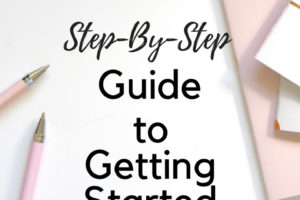
A great way to add additional income to your online business is to add coaching services. In this post, I’m going to share the basic steps to help you figure out what type of coaching your current audience wants, and how you can add coaching to your online business or blog easily.
One of the fastest ways we were able to start monetizing our new blog was by adding coaching services. If you love to teach others about what you know, and you are already blogging and sharing your knowledge, then you can easily add coaching to your online business.
Before we get into how you can add coaching to your online business, you may want to join our Facebook page where we often go live to share tips and answer your questions.
And make sure you subscribe to our YouTube channel and watch our latest video where I share how I got started in life coaching and the steps you can take to do the same!
The steps to add coaching to your online business
1. Write for your audience to create a conversation
One of the easiest ways to test out your audience for what types of coaching you could provide is to write a few blog posts related to their specific (and greatest) struggles and see which post gets the most attention.
The idea here is to start creating a few “conversations” about issues your readers might be facing. After you have published a few pieces, one or two main topics will start to rise to the top as their main “struggles.”
*Note- If you are new to blogging, you may still be “throwing spaghetti at the wall” to see what types of posts get traction. Allow yourself time to post and see what stands out. If you need help with getting your blog set up, click here to go through the steps.
If you have no clue what your audience might be drawn to, in this coaching bundle, we teach you strategies for testing out various ideas! These are the very strategies we have used and teach to our online business owners and coaching clients to develop an authentic connection with their audience.
2. Define what your audience is craving
Now that you have started the conversation, it’s time to define what your current audience wants or needs. How do you find out their exact problem or struggle?
The easiest way to define their struggle is to look to your traffic stats to see what your audience favors on your site.
You also want to be studying the comments from your audience. What questions are they asking? What is their REAL struggle?
When I say “What is their REAL struggle,” what I mean is, you might be thinking they want to “feel better,” but they may call that, “lose 10 pounds.” The point is, don’t get into telling them what you think they need. They will tell you if you listen. The words they are using are probably very simple. The key is to look at the words THEY are using.
3. Give to your audience as a way to test
To take things a step further, create a very simple freebie providing your top tips for your specific audience. You should be testing out blog topics and freebies for interest over a month or two, not being afraid to change out freebies until one stands out as the favorite.
If you’ve done this right, you’ve used their “struggle words” or “goal words” in different freebies to see which ones grab the most attention.
Don’t be afraid to test, test, test! Eventually a few keywords will start to rise to the top, and your job is to simply see what resonates.
Here’s an example of a freebie we use to help our coaches stay focused and avoid the overwhelm!

4. Create a coaching service or offer that fits
Now that you know what is resonating with your audience, it’s time to design an offer that speaks to them.
Creating an offer can be as simple as stating that you have spots open for a few private clients or that you have a group program starting in a month. You don’t need to have a fancy website or ads pointing to a bunch of landing pages.
Many of my new coaching clients simply set up an online schedule calendar, and then they share the appointment links on their social media accounts.
There are many ways to let people know you are available to them to start the conversation. The important thing is to find YOUR way and to figure out where your people are hanging out. Then speak to them and their needs authentically.
Your offer will (and should) be very unique to your coaching business. It’s important to take some time to map out your offer, and then design a launch that fits your lifestyle. If you would like help mapping out your offer and designing a launch, you might want to check out our private coaching where we work with you one-on-one to create a successful launch.
5. Include a “call to action” to activate your audience
There is no right or wrong way to offer coaching, but you want to make sure you are activating your audience when you are sharing your offer.
There are many effective ways to do this without being pushy or salesy. With a “call to action,” you are inviting and directing your audience to take a next step. You are showing them where they can go to get more help or to work with you directly.
Some of my favorite ways to present a “call to action” include… an interest form with access to a helpful freebie, offer a free discovery call to help them take the first step in their transformation, direct them to a private messaging link where they can ask you questions, or invite them to check out the actual offer on a webpage. Test out a few ways, and direct your audience towards helpful information consistently. If you do this often, your ideal clients will start to “stalk” you (in a good way), and may reach out the moment something resonates strongly. When they have decided they are ready, they will work with you. Your job is to just keep showing up!

Final thoughts on how to add coaching to your online business
Hopefully this post shows you how easy it is to add coaching to your online business. Taking note of what is already resonating for your audience is a great first step and can often lead to generating ideas about how you can coach them or help them further.
Remember to look for what is already proving to be of value to your audience, and then expand upon this by creating offers that help them make real change in their life.
If you keep your people’s needs top of mind, and create products and services that really speak to them, they will come back to work with you as they keep growing on their journey. This is the best part of coaching- seeing your clients develop and continue to grow and expand with time!






1 Comment
Leave your reply.